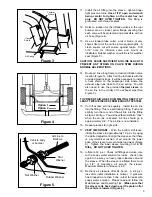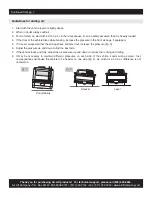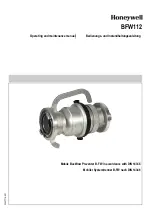
Fig.8 MN 190
Air Line to
Bellows
Star
Washer
Vehicle body
or bumper
Rubber Washer
Flat Washer
Heat
Shield
Air Spring
Thermal
Sleeve
11. Install the air fitting into the sleeve , tighten finger
tight plus two turns.
Use a 7/16” open end wrench
being careful to tighten on the metal hex nut
only. DO NOT OVER TIGHTEN.
This fitting is
precoated with thread sealant.
12. Select a location for the inflation valves in the rear
bumper area or rocker panel flange ensuring that
each valve will be protected and accessible with an
air hose (Figure 4).
13. Use a standard tube cutter, a razor blade, or very
sharp knife to cut the air line in two equal lengths. A
clean square cut will ensure against leaks. Drill
5/16” hole for inflation valve and mount as
illustrated. Rubber washer on outside is for weather
seal (Figure 5).
CAUTION: LEAVE SUFFICIENT AIR LINE SLACK TO
PREVENT ANY STRAIN ON VALVE STEM DURING
NORMAL AXLE MOTIONS.
14. Route air line along frame to desired inflation valve
location (Figure 5). Attach air line to chassis with the
provided plastic straps. It will be necessary to install
a heat shield on the passenger side where the
exhaust pipe runs close to the air spring. You will
also need to use the provided
thermal sleeve
on
the air line in the vicinity of the exhaust pipe (See
Figure 3).
TO PREVENT AIR LINE FROM MELTING, KEEP IT AT
LEAST TWELVE INCHES FROM EXHAUST SYSTEM.
15. Cut off excess air line squarely. Install the air line
into the fitting. This is a self locking fitting. Push and
slightly turn the cut end of the air line into the fitting
as far as it will go. You will hear/feel a definite “click”
when the air line is seated. Air line should go in
approximately 3/4”. The air line is now installed.
16. Repeat process for right side.
17.
VERY IMPORTANT -
With the bottom still loose,
inflate the sleeve to approximately 10 p.s.i. By using
the slotted adjustment, align the sleeve so that there
is a symmetrical cushion of air around the lower
base of the sleeve to prevent side load wear (Figure
6). Tighten the lower sleeve mounting bolt to
10
ft/lbs. DO NOT OVER TIGHTEN.
18. Inflate to 30 p.s.i. Check all fittings and valve core
with a soapy water solution for leaks. check once
again to be sure you have proper clearance around
the sleeve. When the sleeve is inflated there must
be 1/2” of clearance all around the sleeve.
Maximum diameter of sleeve is 4.6”.
19. Recheck air pressure after 24 hours. A 2-4 p.s.i.
loss after initial installation is normal. If pressure
has dropped more than 5 lbs. re-test for leaks with
soapy water solution. Please read and follow the
Maintenance and Operating Tips.
(Make sure that
the sleeve rolls back down over the piston after
the vehicle is lowered (Figure 6).
Figure 3
Figure 5
3
Option 1
Option 2
Figure 4
























